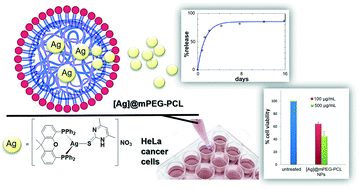Pegylated-polycaprolactone nano-sized drug delivery platforms loaded with biocompatible silver(i) complexes for anticancer therapeutics†
Abstract
Cytotoxic potential of Ag(I) coordination compounds against cancer cells is widely recognized, but their frequently low water solubility and potential adverse interactions of Ag(I) ions in biological media require their incorporation into suitable platforms to ensure effective transport and delivery at target sites. Herein, we developed and evaluated the in vitro cytotoxic activity of a biodegradable copolymer-based nano-sized drug delivery system for three cytotoxically active and lipophillic Ag(I) compounds. In particular, polymer-based nanoparticles of the newly synthesized amphiphilic methoxy-poly(ethylene glycol)–poly(caprolactone) (mPEG–PCL) copolymer were prepared as carriers for [Ag(dmp2SH)(PPh3)2]NO3 (1), [Ag(dmp2SH)(xantphos)]NO3 (2) and [Ag(dmp2S)(xantphos)] (3) (dmP2SH = 4,6-dimethylpyrimidine-2-thiol, xantphos = 4,5-bis(diphenylphosphino)-9,9-dimethylxanthene) which exhibit high cytotoxicity against HeLa cancer cells, while they maintain low toxicity against HDFa normal cells. Taking advantage of the favorable donor–acceptor Lewis acid–base and electrostatic interactions between functional groups of 1–3 and mPEG–PCL copolymer, the formation of [X]@mPEG–PCL (X = 1,2,3) nanoparticles with nearly spherical shape was achieved. Satisfactory loading capacities and encapsulation efficiencies were obtained (13–15% and 80–88%, respectively). Differences in their mean size diameters were observed, revealing a dependence on the individual structural characteristics of the Ag(I) compounds. In vitro release profiles of the nanoparticles showed an initial burst stage, followed by a prolonged release stage extending over 15 days, with their release rates being determined by the mean size of the nanoparticles, as well as the type and crystallinity of the encapsulated Ag(I) compounds. In vitro cytotoxicity studies revealed an increased cytotoxic activity of compounds 1–3 after their encapsulation in mPEG–PCL copolymer against HeLa cells, with the actual concentrations of the loaded compounds responsible for the inhibition of cell viability being reduced by 8 times compared to the compounds in free form. Therefore, the current drug delivery system improves the pharmacokinetic properties of the three cytotoxic and biocompatible Ag(I) compounds, and may be beneficial for future in vivo anticancer treatment.



 Please wait while we load your content...
Please wait while we load your content...